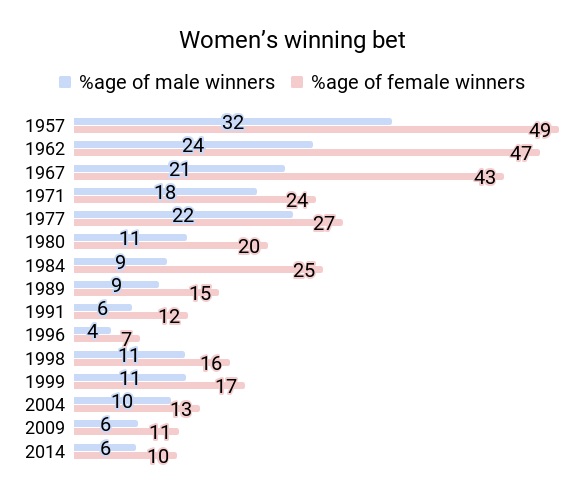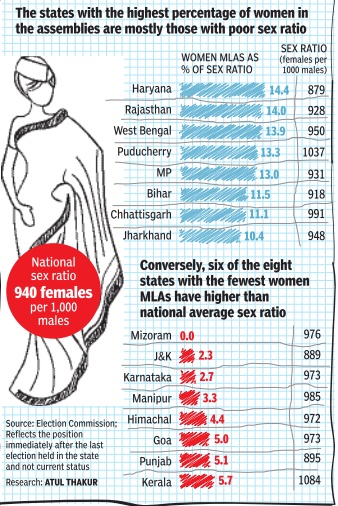Women in politics: India
| Line 8: | Line 8: | ||
[[Category:India |W ]] | [[Category:India |W ]] | ||
[[Category:Politics |W ]] | [[Category:Politics |W ]] | ||
| + | [[Category:Gender issues |W ]] | ||
| + | |||
=Elected representatives= | =Elected representatives= | ||
| − | == | + | ==1954-2014: Women who won== |
| − | [ | + | [https://timesofindia.indiatimes.com/t10-mar-13-2019/timestopten/msid-68377062.cms March 13, 2019: ''The Times of India''] |
| − | + | [[File: %age of women MPs, 1960-2014.jpg|%age of women MPs: 1960-2014 <br/> From: [https://timesofindia.indiatimes.com/t10-mar-13-2019/timestopten/msid-68377062.cms March 13, 2019: ''The Times of India'']|frame|500px]] | |
| + | [[File: %age of male and female winners, respectively- 1954-2014.jpg|%age of male and female winners, respectively: 1954-2014 <br/> From: [https://timesofindia.indiatimes.com/t10-mar-13-2019/timestopten/msid-68377062.cms March 13, 2019: ''The Times of India'']|frame|500px]] | ||
| − | |||
| − | |||
| − | |||
| − | + | '''Dismal record''': For a country whose constitution espouses gender equality, the proportion of female lawmakers in the lower house of the parliament has oscillated between a nadir of 3.50% in 1977 to a peak — or rather a mud mound — of 12.52% in the 16th, or the outgoing Lok Sabha. In fact, the last two parliamentary elections — for the 15th and the 16th Lok Sabha in 2009 and 2014 respectively — have seen the share of elected women MPs increase to over 10% of the parliament’s total strength of 543 members. | |
| − | + | '''Winnable women''': Women candidates have a constantly higher success ratio at the hustings than their male counterparts, with a greater proportion of women winning from among the total number of women contesting the elections, vis-a-vis their male peers. However, that could also be because of a fewer number of women candidates contesting polls — as the number of women candidates rise, their success ratio has also started decreasing from a peak of almost 49%, or nearly half of them, winning in 1957 to 10% in 2014. | |
| − | The | + | '''The male skew''': That parties still prefer male candidates to female candidates — unless they are confident of ‘her’ victory in a constituency — may be gauged from the fact that in the last election alone, in 2014, there were over 7,500 male candidates in the fray. This was almost twice the number of all the female candidates who have ever contested in Lok Sabha elections since the first parliamentary elections in 1951. (Un)fair enough! |
| − | |||
| − | |||
| − | |||
| − | |||
| − | |||
==2011, 2016 Assembly elections in 4 states== | ==2011, 2016 Assembly elections in 4 states== | ||
[http://epaperbeta.timesofindia.com/Article.aspx?eid=31808&articlexml=Only-9-of-women-netas-won-in-4-09052016012071 ''The Times of India''], May 09 2016 | [http://epaperbeta.timesofindia.com/Article.aspx?eid=31808&articlexml=Only-9-of-women-netas-won-in-4-09052016012071 ''The Times of India''], May 09 2016 | ||
| Line 45: | Line 40: | ||
In several states, women outnumber male voters. According to a report, states like Bihar, Rajasthan, Punjab, Odisha, Tamil Nadu and Uttarakhand have a burgeoning female population. | In several states, women outnumber male voters. According to a report, states like Bihar, Rajasthan, Punjab, Odisha, Tamil Nadu and Uttarakhand have a burgeoning female population. | ||
| + | |||
| + | ==Women legislators in the Indian states: 2017== | ||
| + | [[File: Women legislators in the Indian states, 2017.jpg|Women legislators in the Indian states, 2017; [http://epaperbeta.timesofindia.com/Article.aspx?eid=31808&articlexml=STATOISTICS-ONE-GENDER-RATIO-ON-WHICH-HARYANA-PUTS-06042017009056 The Times of India], April 6, 2017 |frame|500px]] | ||
| + | |||
| + | See graphic, 'Women legislators in the Indian states, 2017' | ||
| + | |||
| + | ===2017: candidates and voters=== | ||
| + | [[File: Women candidates and voters as a percentage of the total in the state assembly elections of 2017.jpg| Women candidates and voters as a percentage of the total in the state assembly elections of 2017; [http://epaperbeta.timesofindia.com/Gallery.aspx?id=12_03_2017_020_051_009&type=P&artUrl=Punjab-extends-a-lifeline-and-a-lesson-to-12032017020051&eid=31808 ''The Times of India''], March 12, 2017|frame|500px]] | ||
| + | |||
| + | '''See graphic''': | ||
| + | |||
| + | ''Women candidates and voters as a percentage of the total in the state assembly elections of 2017'' | ||
| + | |||
| + | ==Women in municipal corporations== | ||
| + | ===Delhi=== | ||
| + | Civic seats fail to empower | ||
| + | |||
| + | New Delhi: The three municipal corporations in Delhi now have half of the seats reserved for women. The move to empower women got 156 councillors into the Houses in the 2012 elections against 90 women councillors in 2007. However, it turns out that increasing the number doesn’t mean their male counterparts would accept them as equals. | ||
| + | |||
| + | During a heated discussion on the inauguration of a road under-bridge on January 21, a male councillor of North Delhi Municipal Corporation had threatened and thrown empty water bottles at women councillors in the front row to hush them. The women councillors complained to lieutenant governor Tejendra Khanna and it was decided that 10 marshals would be deployed during meetings for their safety. However, nothing has been done so far. | ||
| + | |||
| + | The same corporations also have less than 20% women staff at the senior level while it has close to 60 such posts. Around 10-12 women head various departments, but there is only one woman additional commissioner in all three corporations. They comprise 35-40% of the total workforce. | ||
| + | |||
| + | The erstwhile MCD was never headed by a woman. Now, all three mayors are women. But this is due to reservation. | ||
| + | |||
| + | New Delhi Municipal Council has a woman, Archna Arora, as its chairperson but there aren’t many women directors. Of the 20 departments, women are heading just three while women comprise around 30% of the total workforce. | ||
| + | |||
=See also= | =See also= | ||
[[Women and crime: India]] | [[Women and crime: India]] | ||
Revision as of 14:30, 16 March 2019
This is a collection of articles archived for the excellence of their content. |
Contents |
Elected representatives
1954-2014: Women who won
March 13, 2019: The Times of India

From: March 13, 2019: The Times of India

From: March 13, 2019: The Times of India
Dismal record: For a country whose constitution espouses gender equality, the proportion of female lawmakers in the lower house of the parliament has oscillated between a nadir of 3.50% in 1977 to a peak — or rather a mud mound — of 12.52% in the 16th, or the outgoing Lok Sabha. In fact, the last two parliamentary elections — for the 15th and the 16th Lok Sabha in 2009 and 2014 respectively — have seen the share of elected women MPs increase to over 10% of the parliament’s total strength of 543 members.
Winnable women: Women candidates have a constantly higher success ratio at the hustings than their male counterparts, with a greater proportion of women winning from among the total number of women contesting the elections, vis-a-vis their male peers. However, that could also be because of a fewer number of women candidates contesting polls — as the number of women candidates rise, their success ratio has also started decreasing from a peak of almost 49%, or nearly half of them, winning in 1957 to 10% in 2014.
The male skew: That parties still prefer male candidates to female candidates — unless they are confident of ‘her’ victory in a constituency — may be gauged from the fact that in the last election alone, in 2014, there were over 7,500 male candidates in the fray. This was almost twice the number of all the female candidates who have ever contested in Lok Sabha elections since the first parliamentary elections in 1951. (Un)fair enough!
2011, 2016 Assembly elections in 4 states
The Times of India, May 09 2016
Only 9% of women netas won in 4 state polls in 2011
While the number of women contestants has more or less stagnated in West Bengal, Assam and Kerala, in Tamil Nadu the number of women contestants has nearly doubled from 6% to 11% since 2011 assembly polls.
Though Bengal has a woman chief minister, only 10% of the tickets went to women in 2016. In Kerala, the number was even less, at 8%. Both states had the same percentage of women candidates in the 2011 polls. Assam improved its tally marginally , with the percentage of women candidates rising from 8% to 9%. The percentage of women winners in the four poll bound states was depressingly low in 2011. In the 2011state polls, the percentage of women who won was about 9%, according to National Election Watch. In Bengal, women won 33 of 285 seats (12%), while in Assam it was only 11% (14 of 126 seats). In TN, the percentage was even lower at 7% (16 of 225 seats) and in Kerala women won only 6% (7 of the 126 seats).
This news comes at a time when parties have acknowledged and are actively wooing the woman voter. This was first seen in the 2014 general elections when the percentage of women voters rose to 65.6% from 55.8% in 2009. The total voter turnout was 66.4%, up from 58.2% in previous polls.
The influence of women voters is reflected in the sops promised by parties, whether it is prohibition, maternity benefits or pension schemes.Tamil Nadu CM Jayalalithaa recently promised to increase financial assistance under a maternity scheme from Rs 12,000 to Rs 18,000, assured to double the quantum of gold for `tali' (mangal sutra), provide subsidy for women to buy scooters and train them to drive. In Bengal, Mamata Banerjee has promised a pension scheme for women and increase in the number of female police personnel.
In several states, women outnumber male voters. According to a report, states like Bihar, Rajasthan, Punjab, Odisha, Tamil Nadu and Uttarakhand have a burgeoning female population.
Women legislators in the Indian states: 2017

See graphic, 'Women legislators in the Indian states, 2017'
2017: candidates and voters

See graphic:
Women candidates and voters as a percentage of the total in the state assembly elections of 2017
Women in municipal corporations
Delhi
Civic seats fail to empower
New Delhi: The three municipal corporations in Delhi now have half of the seats reserved for women. The move to empower women got 156 councillors into the Houses in the 2012 elections against 90 women councillors in 2007. However, it turns out that increasing the number doesn’t mean their male counterparts would accept them as equals.
During a heated discussion on the inauguration of a road under-bridge on January 21, a male councillor of North Delhi Municipal Corporation had threatened and thrown empty water bottles at women councillors in the front row to hush them. The women councillors complained to lieutenant governor Tejendra Khanna and it was decided that 10 marshals would be deployed during meetings for their safety. However, nothing has been done so far.
The same corporations also have less than 20% women staff at the senior level while it has close to 60 such posts. Around 10-12 women head various departments, but there is only one woman additional commissioner in all three corporations. They comprise 35-40% of the total workforce.
The erstwhile MCD was never headed by a woman. Now, all three mayors are women. But this is due to reservation.
New Delhi Municipal Council has a woman, Archna Arora, as its chairperson but there aren’t many women directors. Of the 20 departments, women are heading just three while women comprise around 30% of the total workforce.
See also
Women in senior corporate positions: India